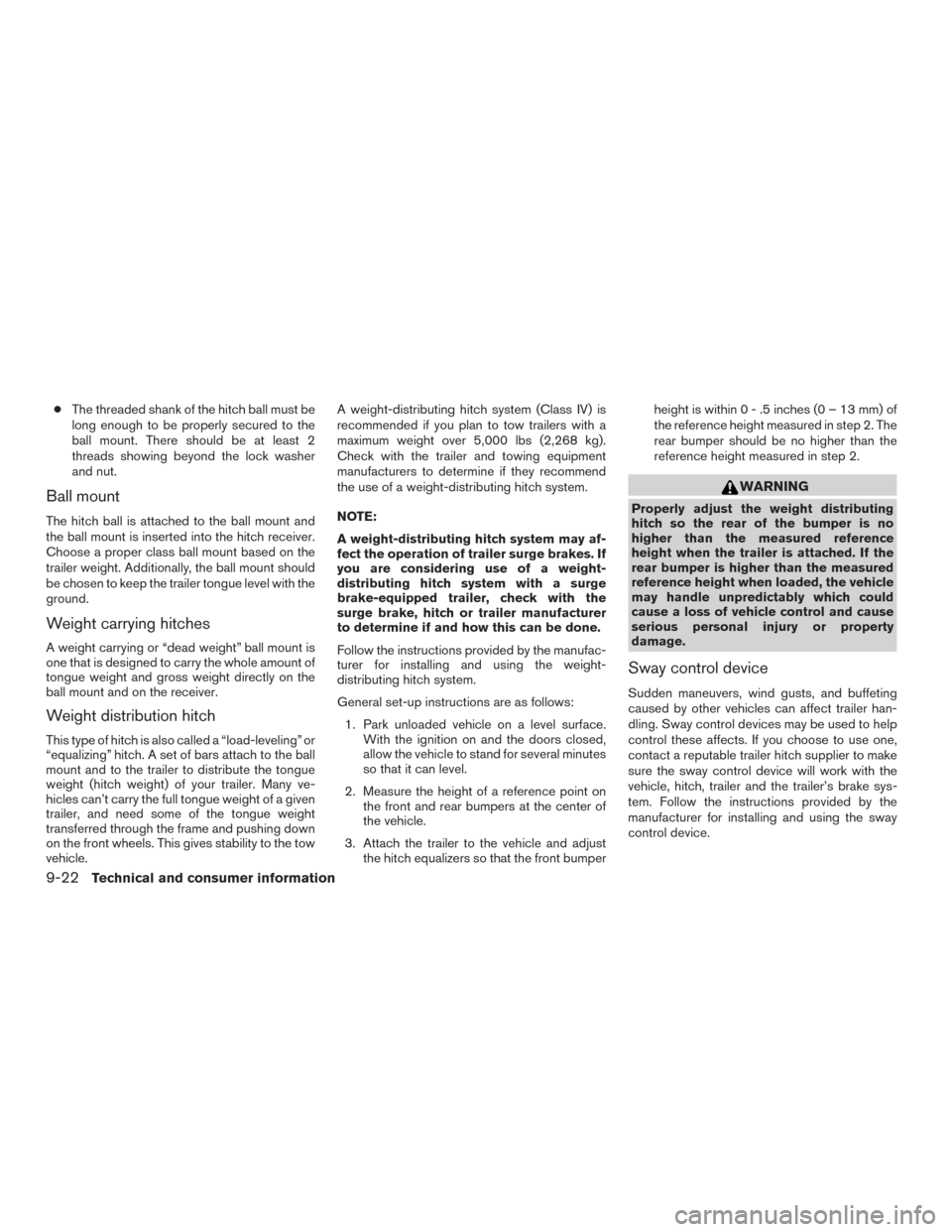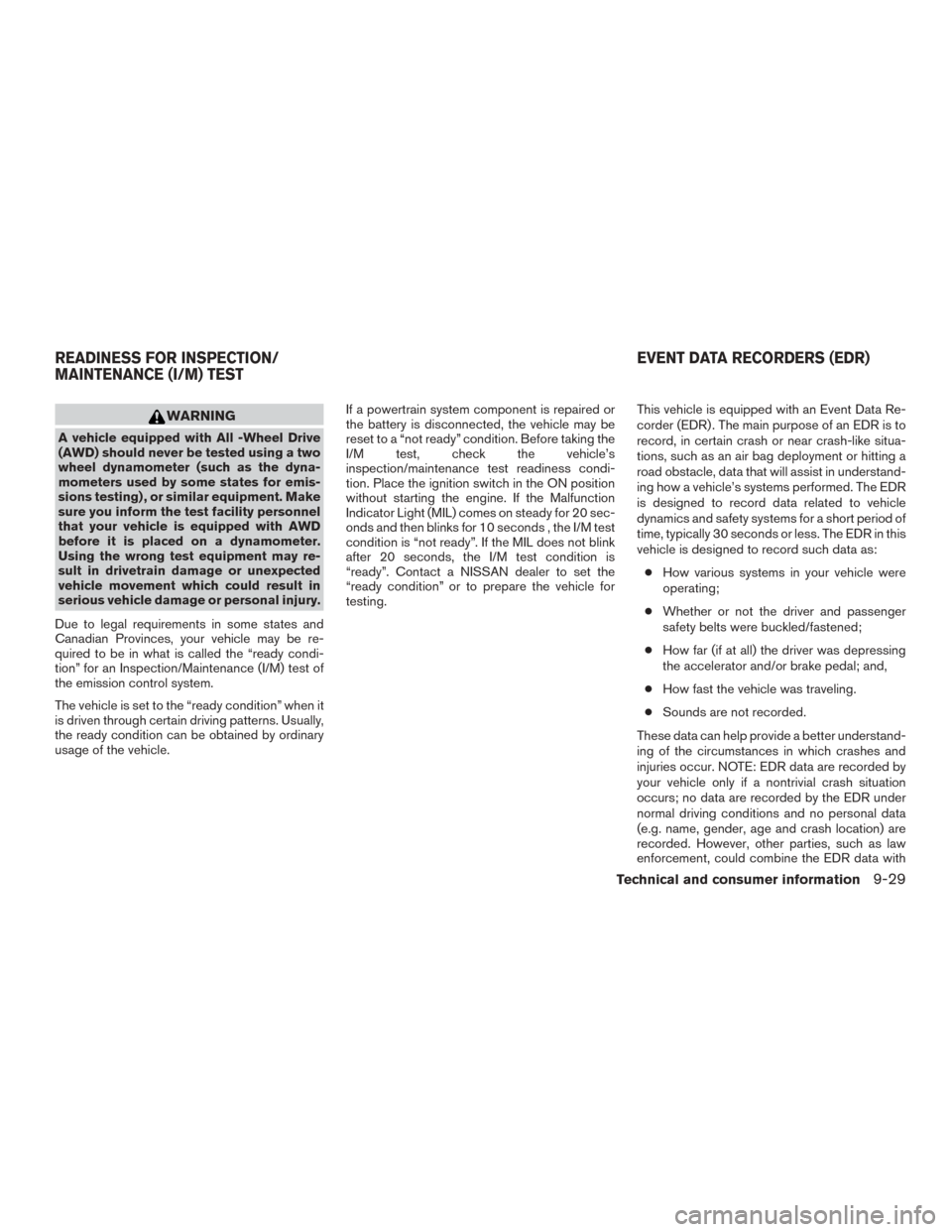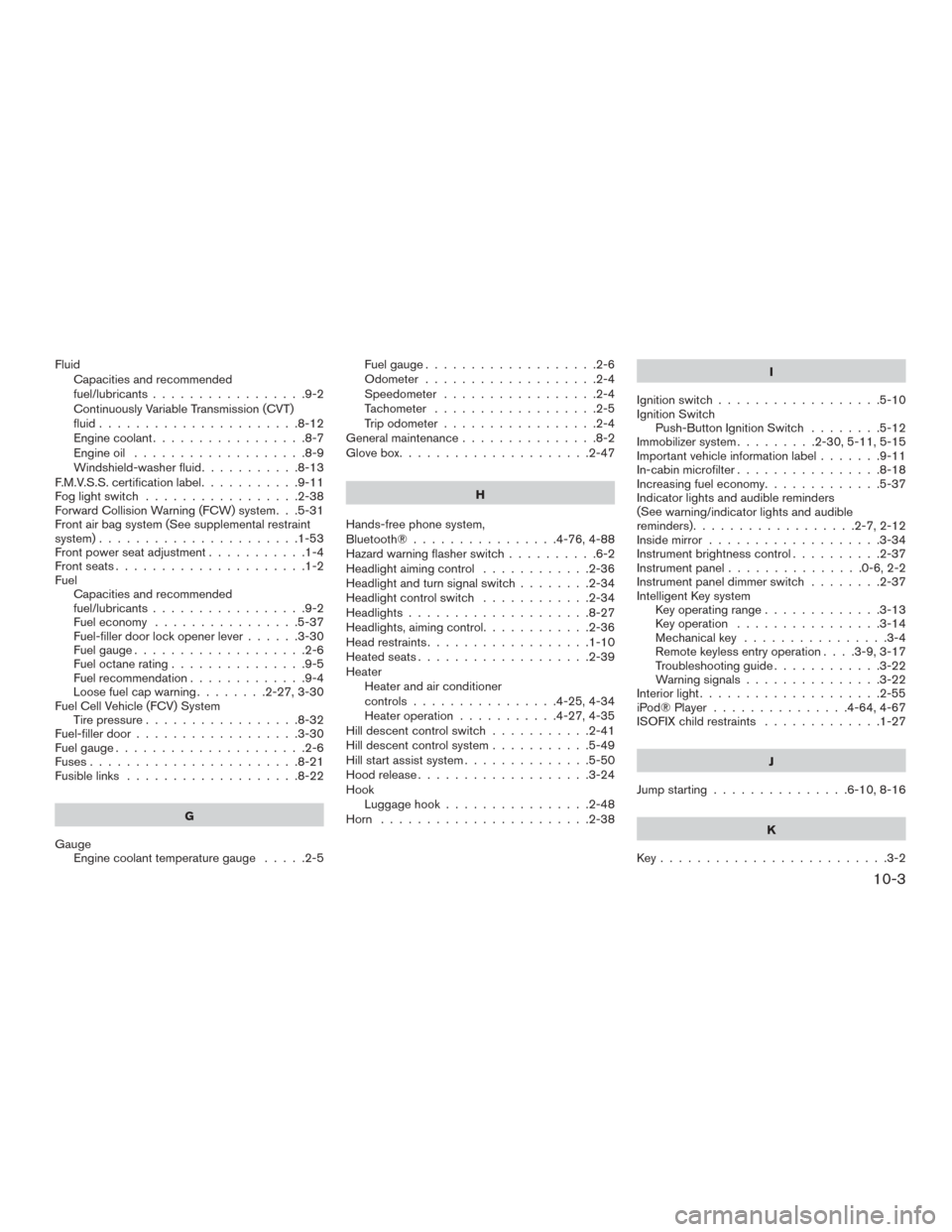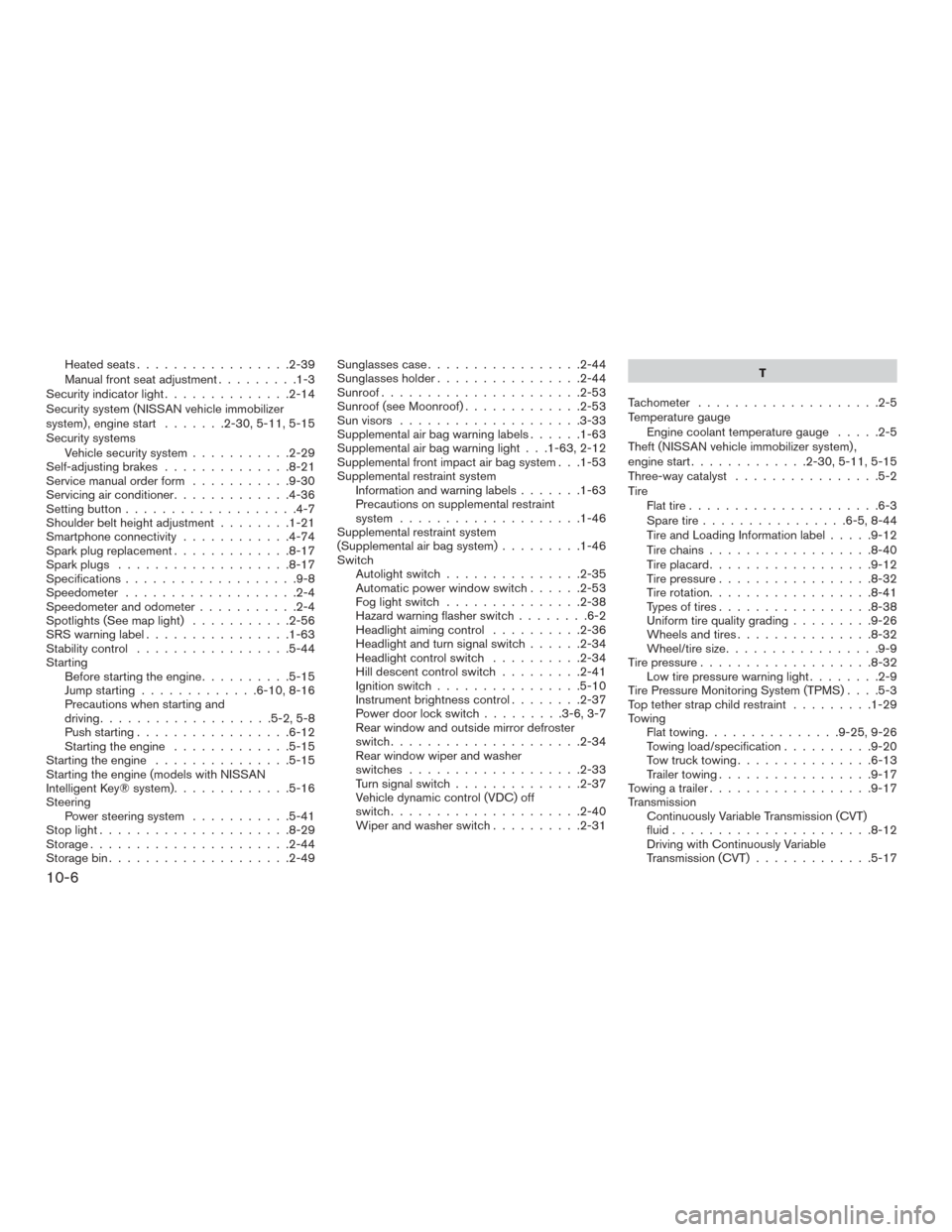2015 NISSAN ROGUE ignition
[x] Cancel search: ignitionPage 423 of 440

●The threaded shank of the hitch ball must be
long enough to be properly secured to the
ball mount. There should be at least 2
threads showing beyond the lock washer
and nut.
Ball mount
The hitch ball is attached to the ball mount and
the ball mount is inserted into the hitch receiver.
Choose a proper class ball mount based on the
trailer weight. Additionally, the ball mount should
be chosen to keep the trailer tongue level with the
ground.
Weight carrying hitches
A weight carrying or “dead weight” ball mount is
one that is designed to carry the whole amount of
tongue weight and gross weight directly on the
ball mount and on the receiver.
Weight distribution hitch
This type of hitch is also called a “load-leveling” or
“equalizing” hitch. A set of bars attach to the ball
mount and to the trailer to distribute the tongue
weight (hitch weight) of your trailer. Many ve-
hicles can’t carry the full tongue weight of a given
trailer, and need some of the tongue weight
transferred through the frame and pushing down
on the front wheels. This gives stability to the tow
vehicle. A weight-distributing hitch system (Class IV) is
recommended if you plan to tow trailers with a
maximum weight over 5,000 lbs (2,268 kg).
Check with the trailer and towing equipment
manufacturers to determine if they recommend
the use of a weight-distributing hitch system.
NOTE:
A weight-distributing hitch system may af-
fect the operation of trailer surge brakes. If
you are considering use of a weight-
distributing hitch system with a surge
brake-equipped trailer, check with the
surge brake, hitch or trailer manufacturer
to determine if and how this can be done.
Follow the instructions provided by the manufac-
turer for installing and using the weight-
distributing hitch system.
General set-up instructions are as follows:
1. Park unloaded vehicle on a level surface. With the ignition on and the doors closed,
allow the vehicle to stand for several minutes
so that it can level.
2. Measure the height of a reference point on the front and rear bumpers at the center of
the vehicle.
3. Attach the trailer to the vehicle and adjust the hitch equalizers so that the front bumper height is within0-.5inches (0 – 13 mm) of
the reference height measured in step 2. The
rear bumper should be no higher than the
reference height measured in step 2.
WARNING
Properly adjust the weight distributing
hitch so the rear of the bumper is no
higher than the measured reference
height when the trailer is attached. If the
rear bumper is higher than the measured
reference height when loaded, the vehicle
may handle unpredictably which could
cause a loss of vehicle control and cause
serious personal injury or property
damage.
Sway control device
Sudden maneuvers, wind gusts, and buffeting
caused by other vehicles can affect trailer han-
dling. Sway control devices may be used to help
control these affects. If you choose to use one,
contact a reputable trailer hitch supplier to make
sure the sway control device will work with the
vehicle, hitch, trailer and the trailer’s brake sys-
tem. Follow the instructions provided by the
manufacturer for installing and using the sway
control device.
9-22Technical and consumer information
Page 430 of 440

WARNING
A vehicle equipped with All -Wheel Drive
(AWD) should never be tested using a two
wheel dynamometer (such as the dyna-
mometers used by some states for emis-
sions testing) , or similar equipment. Make
sure you inform the test facility personnel
that your vehicle is equipped with AWD
before it is placed on a dynamometer.
Using the wrong test equipment may re-
sult in drivetrain damage or unexpected
vehicle movement which could result in
serious vehicle damage or personal injury.
Due to legal requirements in some states and
Canadian Provinces, your vehicle may be re-
quired to be in what is called the “ready condi-
tion” for an Inspection/Maintenance (I/M) test of
the emission control system.
The vehicle is set to the “ready condition” when it
is driven through certain driving patterns. Usually,
the ready condition can be obtained by ordinary
usage of the vehicle. If a powertrain system component is repaired or
the battery is disconnected, the vehicle may be
reset to a “not ready” condition. Before taking the
I/M test, check the vehicle’s
inspection/maintenance test readiness condi-
tion. Place the ignition switch in the ON position
without starting the engine. If the Malfunction
Indicator Light (MIL) comes on steady for 20 sec-
onds and then blinks for 10 seconds , the I/M test
condition is “not ready”. If the MIL does not blink
after 20 seconds, the I/M test condition is
“ready”. Contact a NISSAN dealer to set the
“ready condition” or to prepare the vehicle for
testing.
This vehicle is equipped with an Event Data Re-
corder (EDR) . The main purpose of an EDR is to
record, in certain crash or near crash-like situa-
tions, such as an air bag deployment or hitting a
road obstacle, data that will assist in understand-
ing how a vehicle’s systems performed. The EDR
is designed to record data related to vehicle
dynamics and safety systems for a short period of
time, typically 30 seconds or less. The EDR in this
vehicle is designed to record such data as:
● How various systems in your vehicle were
operating;
● Whether or not the driver and passenger
safety belts were buckled/fastened;
● How far (if at all) the driver was depressing
the accelerator and/or brake pedal; and,
● How fast the vehicle was traveling.
● Sounds are not recorded.
These data can help provide a better understand-
ing of the circumstances in which crashes and
injuries occur. NOTE: EDR data are recorded by
your vehicle only if a nontrivial crash situation
occurs; no data are recorded by the EDR under
normal driving conditions and no personal data
(e.g. name, gender, age and crash location) are
recorded. However, other parties, such as law
enforcement, could combine the EDR data with
READINESS FOR INSPECTION/
MAINTENANCE (I/M) TEST EVENT DATA RECORDERS (EDR)
Technical and consumer information9-29
Page 434 of 440

FluidCapacities and recommended
fuel/lubricants .................9-2
Continuously Variable Transmission (CVT)
fluid......................8-12
Engine coolant .................8-7
Engine oil ...................8-9
Windshield-washerfluid...........8-13
F.M.V.S.S. certification label ...........9-11
Foglightswitch .................2-38
Forward Collision Warning (FCW) system. . .5-31
Front air bag system (See supplemental restraint
system) ......................1-53
Front power seat adjustment ...........1-4
Frontseats.....................1-2
Fuel Capacities and recommended
fuel/lubricants .................9-2
Fuel economy ................5-37
Fuel-filler door lock opener lever ......3-30
Fuel gauge ...................2-6
Fuel octane rating ...............9-5
Fuel recommendation .............9-4
Loose fuel cap warning ........2-27,3-30
Fuel Cell Vehicle (FCV) System Tirepressure.................8-32
Fuel-filler door ..................3-30
Fuel gauge .....................2-6
Fuses.......................8-21
Fusible links ...................8-22
G
Gauge Engine coolant temperature gauge .....2-5Fuel gauge
...................2-6
Odometer ...................2-4
Speedometer .................2-4
Tachometer ..................2-5
Trip odometer .................2-4
General maintenance ...............8-2
Glovebox.....................2-47
H
Hands-free phone system,
Bluetooth®................4-76,4-88
Hazard warning flasher switch ..........6-2
Headlight aiming control ............2-36
Headlight and turn signal switch ........2-34
Headlight control switch ............2-34
Headlights ....................8-27
Headlights, aiming control ............2-36
Head restraints ..................1-10
Heated seats ...................2-39
Heater Heater and air conditioner
controls................4-25,4-34
Heater operation ...........4-27,4-35
Hill descent control switch ...........2-41
Hill descent control system ...........5-49
Hill start assist system ..............5-50
Hood release ...................3-24
Hook Luggage hook ................2-48
Horn .......................2-38 I
Ignition switch ..................5-10
Ignition Switch Push-Button Ignition Switch ........5-12
Immobilizer system .........2-30,5-11,5-15
Important vehicle information label .......9-11
In-cabin microfilter ................8-18
Increasing fuel economy .............5-37
Indicator lights and audible reminders
(See
warning/indicator lights and audible
reminders)..................2-7,2-12
Inside mirror ...................3-34
Instrument brightness control ..........2-37
Instrumentpanel...............0-6,2-2
Instrument panel dimmer switch ........2-37
Intelligent Key system Key operating range .............3-13
Key operation ................3-14
Mechanical key ................3-4
Remote keyless entry operation ....3-9,3-17
Troubleshooting guide ............3-22
Warning signals ...............3-22
Interior light ....................2-55
iPod®Player ............... 4-64, 4-67
ISOFIX child restraints .............1-27
J
Jump starting ...............6-10,8-16
K
Key.........................3-2
10-3
Page 437 of 440

Heatedseats.................2-39
Manual front seat adjustment.........1-3
Security indicator light ..............2-14
Security system (NISSAN vehicle immobilizer
system) , engine start .......2-30,5-11,5-15
Security systems Vehicle security system ...........2-29
Self-adjusting brakes ..............8-21
Service manual order form ...........9-30
Servicing air conditioner .............4-36
Setting button ...................4-7
Shoulder belt height adjustment ........1-21
Smartphone connectivity ............4-74
Spark plug replacement .............8-17
Spark plugs ...................8-17
Specifications ...................9-8
Speedometer ...................2-4
Speedometer and odometer ...........2-4
Spotlights(Seemaplight) ...........2-56
SRS warning label ................1-63
Stability control .................5-44
Starting Before starting the engine ..........5-15
Jump starting .............6-10,8-16
Precautions when starting and
driving ...................5-2,5-8
Push starting .................6-12
Starting the engine .............5-15
Starting the engine ...............5-15
Starting the engine (models with NISSAN
Intelligent Key® system) .............5-16
Steering Power steering system ...........5-41
Stoplight.....................8-29
Storage......................2-44
Storagebin....................2-49 Sunglassescase.................2-44
Sunglassesholder................2-44
Sunroof......................2-53
Sunroof(seeMoonroof).............2-53
Sun visors
....................3-33
Supplemental air bag warning labels ......1-63
Supplemental air bag warning light . . .1-63, 2-12
Supplemental front impact air bag system . . .1-53
Supplemental restraint system Information and warning labels .......1-63
Precautions on supplemental restraint
system ....................1-46
Supplemental restraint system
(Supplemental air bag system) .........1-46
Switch Autolightswitch...............2-35
Automatic power window switch ......2-53
Foglightswitch ...............2-38
Hazard warning flasher switch ........6-2
Headlightaimingcontrol ..........2-36
Headlight and turn signal switch ......2-34
Headlight control switch ..........2-34
Hill descent control switch .........2-41
Ignition switch ................5-10
Instrument brightness control ........2-37
Power door lock switch .........3-6,3-7
Rear window and outside mirror defroster
switch.....................2-34
Rear window wiper and washer
switches...................2-33
Turn signal switch ..............2-37
Vehicle dynamic control (VDC) off
switch.....................2-40
Wiperandwasherswitch..........2-31 T
Tachometer ....................2-5
Temperature gauge Engine coolant temperature gauge .....2-5
Theft (NISSAN vehicle immobilizer system) ,
engine start .............2-30,5-11,5-15
Three-way catalyst ................5-2
Tire Flat tire .....................6-3
Spare tire ................
6-5,8-44
Tire and Loading Information label .....9-12
Tire chains ..................8-40
Tire placard ..................9-12
Tire pressure .................8-32
Tire rotation..................8-41
Types of tires .................8-38
Uniform tire quality grading .........9-26
Wheels and tires ...............8-32
Wheel/tire size .................9-9
Tirepressure...................8-32 Low tire pressure warning light ........2-9
Tire Pressure Monitoring System (TPMS) ....5-3
Top tether strap child restraint .........1-29
Towing Flattowing...............9-25,9-26
Towing load/specification ..........9-20
Towtrucktowing...............6-13
Trailer towing .................9-17
Towing a trailer ..................9-17
Transmission Continuously Variable Transmission (CVT)
fluid......................8-12
Driving with Continuously Variable
Transmission (CVT) .............5-17
10-6